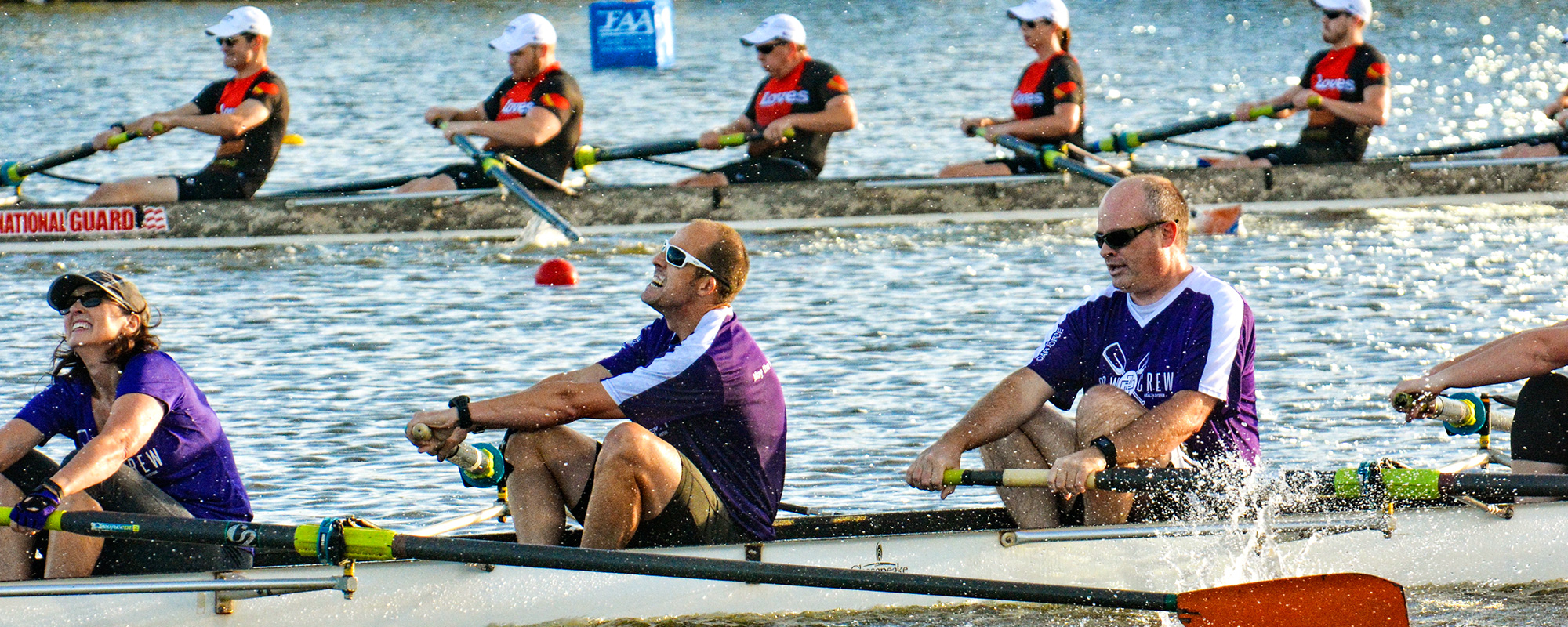
Rowing 101
Rowing is a sport that uses all of the body’s major muscle groups: arms, legs, back, abs and buttocks. The power comes from the legs, while it takes core and upper body strength to transfer that power into the stroke. Rowing also requires balance, flexibility and coordination – plus mental focus to keep a crew in sync. It’s a great aerobic workout often compared to cross-country skiing, and because it’s low impact, can be an alternative to running for those with knee injuries.
Olympic-style Rowing
Rowers sit facing the rear of the boat and wield an oar that pivots in an oarlock. Boats are called shells. Rowers either scull (row with two oars) or sweep row (one oar). The rowing team is called a “crew.”
Men and women of all ages row both competitively and for pleasure. Rowers who are sculling (rowing with two oars) compete in single, double and quad events. In sweep rowing (one oar) there are racing events for pairs, fours or eights. The “eight” is the most impressive of the boats and is approximately 60 feet long. It accommodates eight rowers perched on sliding seats.
The Crew
Athletes are identified by their position in the boat. The athlete sitting in the bow, the part of the boat that crosses the finish line first, is the bow seat or No. 1 seat. The person in front of the bow is No. 2, then No. 3 and so on. The rower closest to the stern that crosses the finish line last is known as the stroke. The stroke of the boat must be a strong rower with excellent technique, as the stroke is the person who sets the rhythm of the boat for the rest of the rowers.
Coxswain
Some boats are equipped to accommodate a coxswain (pronounced cox’n) who doesn’t row but uses a rudder to steer. The “cox” also coaches the rowers throughout the race. The coxswain is tucked into a seat at the stern of the boat and uses a “cox box” to amplify his/her voice throughout the boat.
Race Types
Olympic style races are held on a 2,000 meter course; longer races are called “head” races and cover 5,000 meters. The shortest races are either 500 or 1,000 meters and are called sprints.
Rowing Divisions
Rowers are categorized by age, sex and weight. Age categories for racing including junior (under 18); collegiate; adult (18-24); and masters (over age 24). Masters races are usually subdivided into age categories. There are two weight categories: lightweight and open weight.
Strokes Per Minute
Rowers speak in terms of strokes per minute (SPM). The stroke rate at the start is high, approximately 38 to 45, even into the 50s for an eight – and then “settles” to a race cadence typically in the 30s. Crews sprint to the finish, taking the rate up once again. Crews may call for a “Power 10” during the race – a demand for the crew’s most intense 10 strokes.
The Athletes
Rowing is a total body workout. Although upper body strength is important, the strength of the rowing stroke comes from the legs. Rowing is one of the few athletic activities that involves all of the body’s major muscle groups. It is a great aerobic workout, in the same vein as cross-country skiing, and is low-impact on the joints.
The Equipment
Rowing boats are called shells, and are made of lightweight carbon fiber. The smallest boat on the water is the single which is only 27 to 30 feet long, a foot wide and approximately 30 pounds. Eights are the largest boats at 60 feet and a little over 200 pounds. Oars are each about 9.5 ft long. Sweep oars are longer than sculling oars, typically with carbon fiber handles and rubber grips.
The Ultimate Team Sport
Rowing isn’t a great sport for athletes looking for MVP status. It is, however, teamwork’s best teacher. The athlete trying to stand out in an eight will only make the boat slower. The crew made up of individuals willing to sacrifice their personal goals for the team will be on the medal stand together.
Adapted from www.usrowing.com


